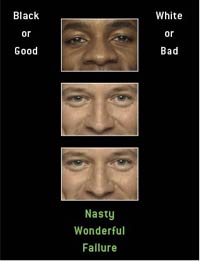JENA 6: Commentary
The Situationist has this thoughtful commentary that was posted last week. It's long but if you have time to read it, it's certainly worth it. Bringing a voice and a rise in national consciousness around the racial disparity in our criminal justice has been long in coming, but now it seems to have arrived....Jena 6 and the Crack Sentencing laws are outlining a problem that is undercover and needs to be exposed for what it is.
Part I of this series summarizes events giving rise to the march and protest last week in Jena, Louisiana. The protest was motivated largely by a shared sense that events in Jena reveal race-based disparities in our criminal justice system and constitute the visible tip of a largely ignored iceberg of racial disparities throughout the criminal-law system (and perhaps beyond).
This post briefly highlights some evidence to suggest that, indeed, there are immense disparities beneath the surface, of which the “Jena 6″ may constitute only a tiny, visible tip. Below, we excerpt portions of a recent Newsweek interview by Eve Conant of David Jacobs about his recent research finding significant racial disparities in U.S. execution rates. We begin, however, with a reprise of an excerpt from a previous post by Situationist contributors Jon Hanson & Michael McCann entitled “Black History is Now.“
[To many, the events in Jena suggest that despite claims of progress, this country has not come so far after all. S]ocial scientists have amassed [a great deal of evidence] indicating the continued influence of robust race-based stereotypes and prejudices. Worse still, the evidence is that those beliefs and feelings . . . are ubiquitous. And here may be the worst part: whatever our conscious or explicit attitudes and intentions, today’s social psychologists have discovered a set of biases that operate beneath the radar of those salient, accessible, and misleading cognitive features.
Such attitudes, sometimes called “implicit associations,” have been uncovered, for instance, through an internet-based experiment called the implicit association test (or IAT) . . . . (Among others, two Contributors to The Situationist, Mahzarin Banaji and Brian Nozek, have been integral in developing the methodology and analyzing the meaning of its results. And among legal scholars, two other Contributors to The Situationist, Jerry Kang and Linda Hamilton Krieger, have been especially active in exploring the possible implications of those results for particular areas of law.)
 In the Race IAT, subjects take a timed test in which they are shown a computer screen and asked to match positive words (love, wonderful, peace) or negative words (evil, nasty, failure) with faces of African-Americans or Whites. Very roughly, subjects who take less time to link positive words with Whites and more time to link positive words with Blacks—or who are quicker at connecting negative words with Blacks and slower at connecting negative words with Whites—demonstrate an implicit bias for white faces or against Blacks. You can take the test yourself by clicking here. Millions of people have. And, among other findings, the IAT test reveals that approximately three-quarters of White subjects and half of the Black subjects show such a bias. . . .
In the Race IAT, subjects take a timed test in which they are shown a computer screen and asked to match positive words (love, wonderful, peace) or negative words (evil, nasty, failure) with faces of African-Americans or Whites. Very roughly, subjects who take less time to link positive words with Whites and more time to link positive words with Blacks—or who are quicker at connecting negative words with Blacks and slower at connecting negative words with Whites—demonstrate an implicit bias for white faces or against Blacks. You can take the test yourself by clicking here. Millions of people have. And, among other findings, the IAT test reveals that approximately three-quarters of White subjects and half of the Black subjects show such a bias. . . .
But wait a minute. If the bias is only implicit and subconscious, how important can it be? Here, too, the news is bad. Although the research is by now piled high and the findings, at time complex, the results can be fairly summarized as follows: implicit bias influences behavior in the way that we assume (often incorrectly) explicit attitudes do. Put differently, the “attitudes” that we do not perceive in ourselves are often more powerful in shaping our conduct than are the attitudes of which we are conscious — situation eclipses disposition.
Other research illustrates that the distinctions made among various shades of “gray”. . . have important behavioral consequences for adults. For instance, Elizabeth Klonoff and Hope Landrine’s study “Is Skin Color a Marker for Racial Discrimination” found that “dark-skinned Blacks were 11 times more likely to experience frequent racial discrimination than their light-skinned counterparts.” Similarly, Rodolfo Espino and Michael M. Franz’s study “Latino Phenotypic Discrimination Revisited: The Impact of Skin Color on Occupational Status” finds that “dark-skinned Mexican Americans and Cuban Americans continue to face higher levels of discrimination in the labor market.”







No comments:
Post a Comment